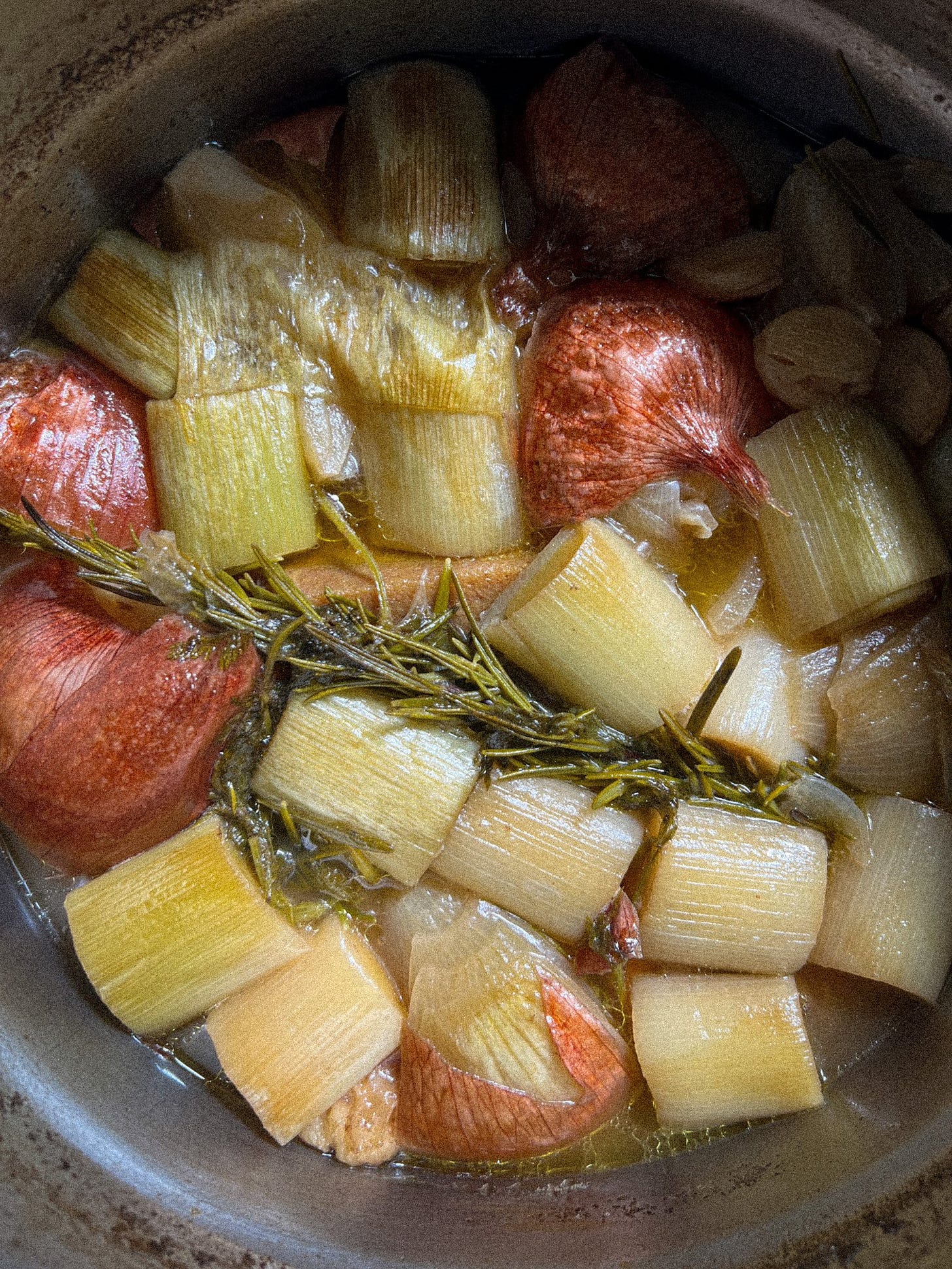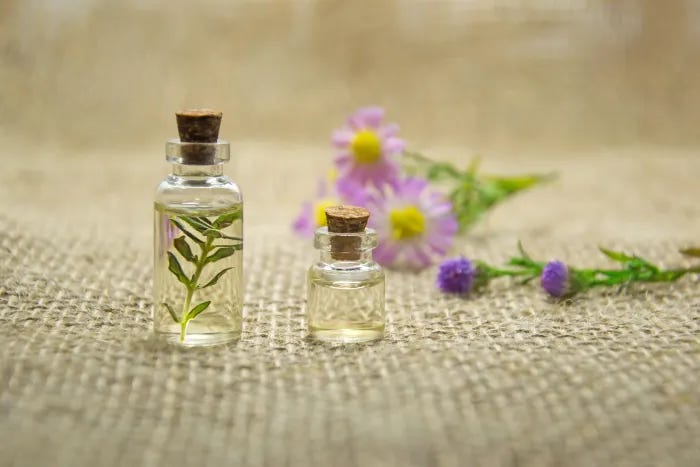#101 The Broth Method
Fall calls for hearty broth
As the days get colder, the urge to make some nourishing, homemade broth will get stronger and stronger. See, the thing with broth is its one of those foods that you have to make at home. No matter how much money you spend on pre-made broths, they’re almost always sub-par and usually packaged in some kind of plastic. The exception is if you get it from a good local farmer’s market, of course!
Remember, broth is an EXTRACTION. It's an age-old practice and one of the best things you can do for your health. For the longest time, broths have been used to nourish and health the body. However, in recent times, this tradition has been lost, with broths missing from the average person’s diet. One reason why could be the common misconception that making broth is an incredibly complicated process. In reality, it is actually one of the simplest things to make and yet one of the most nutritious foods you can eat. Here’s how you can easily create your own broth and incorporate it into your daily routine. Don’t let the lack of knowledge hold you back from reaping the benefits of this ancient practice.
Stock or broth?
These are the common terms you might come across if you’ve ever searched for a broth recipe.
Stock: A liquid extraction from the bones of the animal. (i.e. chicken stock is an extraction made just from chicken bones)
Broth: A liquid extraction from bones, gelatinous cuts of the animal, and a myriad of vegetables, herbs and spices. Broths can also be made from a mixture of different types of animals, resulting in unique flavors.
Other terms for broth include bouillon (French) and brodo (Italian)
How do you make broth?
A common misconception is that broths need 12 thousand different steps to follow and that if you miss one, you’re not doing it right. What is a broth? It’s essentially an extraction of nutrients. You’re applying heat over an extended period of time to extract nutrients out of bones and gelatinous cuts of meat, with water as the medium. This essentially means that the most basic concept of a broth is to simmer some bones in water. All you’re doing is letting gentle heat do the work. The longer you take, the more nutrients you’re extracting. Adding herbs, spices, aromatics and other cuts of meat only deepen the flavor of the broth and gives it an edge. So don’t be intimidated by the thought of making a broth — it’s actually a relatively straightforward process.
What do you need?
Start making your broth as early in the morning as possible. Ideally, you do not want to keep your stove on overnight just in case anything unfortunate happens. While you don’t actually need to be an entire day to cook broth, you’ll want to at a few hours for this (of which most of it will be spent just waiting). I’d say 3 hours is a minimum you’d want to shoot for and you can go for as long as 18-24 hours.
Divide your ingredients for the broth into three categories:
Meat and bones
Vegetables
Herbs & Spices
You’ll be placing these items in the pot in that same order. Depending on how much meat and bones you have, use a stainless steel pot of the appropriate size.
Kitchen utensils you’ll need:
Stainless steel pot or dutch oven
Strainer or a sieve with small to medium sized holes
Mason jar to collect and store broth
The Specific Ratios
While some go crazy on the measurements and weigh everything down to the minute gram, I really believe it’s redundant. The rule of thumb I follow is to get the pot (without any water filled) and to place your meat and bones at the base. You’ll want to make sure it’s about a third or a quarter of the way full. And then you fill it up. It’s better for to end up with more water than to have less. So fill it about 1.5 inches off the rim. You can always remove some if you find you’ve added too much but you don’t want to add water midway — it’ll disrupt the process and result in a cloudier broth.
Method
Bones in
Place your bones in the pot and they should take about a quarter to a third of the spaceFill with water
Fill the pot with water and leave 1.5-2 inches off the top
(what this does is allows you to shoot for a 1/3 meat to 2/3 water ratio without needing to weigh it all, which you can if you want)Bring to a simmer
On medium heat, bring the pot up to a simmer, to where you see small to medium sized bubbles rising to the top. It shouldn’t be bubbling aggressively — that would result in a cloudy broth.Skim the “scum”
A foamy white cloud known as “scum” will start appearing on the surface. It’s denatured protein that’s fine to eat but we traditionally remove it for a clearer broth. Use the strainer and skim it off the surface.Constant simmer
Lower the heat and make sure the simmer doesn’t turn into a boil. If it does, your effort of removing the scum will go to waste. You could choose to continue removing scum as you watch the broth or do it all at the end.Time to wait
Now, we wait. Let the bones simmer like that for a few hours. How long? It’s up to you. I’d say try getting at least 4-6 hours in but I know people who’ve even done 30 minutes. The longer you wait, the more nutritious it becomes.Adding Vegetables
You’ll want to add vegetables about two hours before your estimated finish time for the broth. They don’t need as long as the bones for extraction. Common ingredients you could use here: onions, garlic celery, carrots, leeks, any scraps you have in your refrigerator.Adding Aromatics
I like adding herbs and spices towards the last hour of the process, but if you’re short on time you could add them with the vegetables. Anything within the last hour or two would work. Common ingredients you could use here: rosemary, thyme, pepper, fennel, peppers, peppercorns, parsley, etc. This is also where you take a little taste and salt accordingly.
Optional Steps
1. Soaking bones in cold water
You can soak the bones in a bowl of cold water prior to making the broth. What this does is reduces the amount of scum in the broth, which will help you get a clearer final product. Simply wash the bones and leave them submerged in a bowl of cold water for about an hour.
2. Browning
Browning what you’re putting in the broth will increase the depth of flavor. However, if you’re short on time, you can just start cold.
How do you store broth?
Storing your broth properly is key to ensuring it stays fresh and flavorful. They last for about five days in the refrigerator. After straining the bones out, allow the broth to come to room temperature before storing. You can strain the broth further using a cloth or other fine sieve to clarify it.
To extend the shelf life of your broth, divide it into smaller portions and store in freezer safe mason jars / glass containers. These smaller portions would act as individual servings you could freeze and use at another time. You could even freeze them as ice cubes that you could use for an even smaller serving size.
Frequently Asked Questions
How finely should I chop my vegetables / meat?
It depends on how much flavor you want. The finer you chop, the more surface area there is, meaning you’ll get a more potent flavor. You can chop finely, or coarsely, it really does not matter in the grand scheme of things. Don’t however, chop something finely if you don’t want strong notes of it in your broth. Alternatively, you could use less of something that’s more finely chopped.
Should I use a lid?
A lid on without a steam vent could cause the broth to bubble and boil, especially if the heat isn’t turned low enough. I’d say you can leave it covered or just halfway so the heat would be under control.
Do you eat the meat or vegetables afterward?
No, the only thing you keep is the liquid. Strain and discard everything else. All the good stuff has been extracted.
Should what I use be raw or cooked?
You can use both. The beauty of a broth is it’s ability to extract nutrients out of just anything. Back in the day, it’s why people would keep whatever scraps they had throughout the week in the refrigerator and use all of it to make broth. It’s a good practice.
How long do I cook for?
It depends on how much time you have. Usually, it is best to start in the early mornings, and end late at night, since you don't want to leave a stove unattended while you're asleep. You can also use a pressure cooker or an instant pot to speed things up.
Can I reduce it?
Yes you can, especially if you don’t have that much freezer space. Transfer the broth to a separate pot and let it simmer so more water is evaporated. You don’t want to use a lid here.
Does when I put the salt in matters?
Not really in the grand scheme of things but the reason why I say to add it towards the end is so that you can control it. With certain meats, sometimes the broth wouldn’t need as much salt as you would with others. Adding too much at the start would be an unnecessary problem.
"The broth is the soul of the kitchen. It is the heart of the pot-au-feu and the foundation of great sauces. Without it, one is nothing. It is the source of life, the most ancient and most powerful of foods. It is the living symbol of culinary art. Good broth will resurrect the dead"
— Auguste Escoffier
Butter mounds must return
We need to bring back mounds of glorious (unpasteurized) butter 🧈
Healthy fast food is possible
Imagine fast food that’s actually healthy. It’s very possible. All you have to do is look at an old McDonald’s menu.
You need to be juicing
You need to be juicing
Thinking about honeycomb… This is your sign to get some this week!
❋ HOW TO MAKE HOMEMADE PERFUMES WITH ESSENTIAL OILS
Everyone talks about how bad and endocrine-disrupting modern perfumes are. But did you know that we’ve been perfuming for eons? The best scents in the world are found in nature and you can actually make some really nice homemade perfumes with essential oils. At one point in time, perfumes were even called love oils.
When making your own perfume, you can try to experiment with different types of essential oils to achieve the scent you want. Below is just a sample of how the procedure works, and you are free to substitute some of the ingredients.
Wedding Nerves
Combine the following essential oils with their corresponding formula:
1 drop of patchouli
2 drops of lemon
4 drops of jasmine
Self Belief
Combine the following essential oils with their corresponding formula:
2 drops of ginger
3 drops each for verbena and myrtle
4 drops of rosemary
❋ HOW TO MAKE SOFT BOILED EGGS
Lately, I can’t get enough of soft boiled eggs. It’s such a great way to start your day off, especially if you have it with some perfectly toasted sourdough. This is by far the best way to make them (ice water or even room temperature water is a key to peel easily) and this instant pot method is very interesting!
I will just go ahead and say it. Soft boiled eggs are my favorite way to eat eggs. You just can’t beat the cooked egg whites with the runny yolks. It’s truly the best of both words.
Oh, the options are endless for these yummy eggs! Add them to a salad, top a piece of toast, eat them with some sweet potato cubes, or enjoy them with some Everything Bagel seasoning. Sometimes, we will eat them with a sprinkle of salt and pepper, and that’s it.
❋ HOW SARDINES AND ANCHOVIES ARE DIFFERENT
If you’re a long time follower you know how much I love sardines. They’re an incredible source of nutrients and omega 3s. They’re one of the best quick snacks you can get. Anchovies are similar, but they’re not quite the same… Here’s what you need to take note if you ever want to swap them in a recipe!
Although they're both small oily fish, the key difference between anchovies and sardines is how they're processed, which gives them distinctively different flavors. Sardines are typically gently cooked and canned, whereas anchovies are salted and cured before they are canned or jarred—or, in Asian countries, dried. Both fish can be grilled or fried when fresh.
Anchovies and sardines generally aren't interchangeable.
❋ Read our latest WARKITCHEN magazines:
❋ Get your copy of Optimal Fuel: Your Nutrition Playbook here. It's a cookbook and nutrition guide — all in one. All proceeds goes towards an outrageous amount of hearty ribeyes and raw honey!
❋ If you’d like to contribute an article or sponsor a future issue, please send us your pitch to rocky@warkitchen.net.
❋ We release a digital magazine issue every month. Explore the full archive here.
❋ Adding us (rocky@warkitchen.net) to your contacts, or moving us to primary will make sure you continue receiving these emails. Connect with us on all our socials.
Hope you had a beautiful weekend ladies & gents,
Godspeed!





















De…pouillage!!
I use a crockpot on low and give it 24 to 48 hours. Keep taking fresh hot broth and replacing bones.